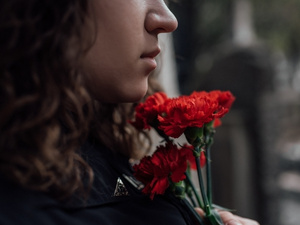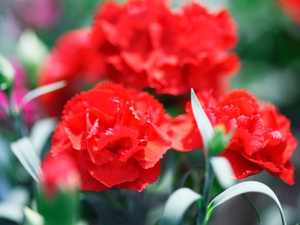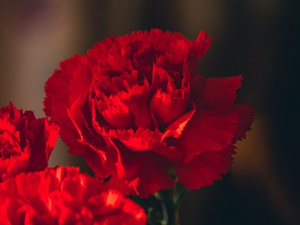The national flower of Spain is the red carnation, which is known as the “cardenal” in Spanish. This vibrant and striking flower is a symbol of love and is often used in bouquets and arrangements for special occasions.

The Carnation has a long history in Spain and used to be widely grown and used throughout the country. Today, it is mainly grown in Aragon and Andalusia.
It takes six to eight weeks to grow fully.
The flower’s attractive fragrance and colorful appearance make it a popular choice for decoration during times of celebration, which are frequent in Spain.
How is the red carnation used in Spain?
It is common to use the red carnation for special occasions in Spain, such as weddings, birthdays, and anniversaries.
It is also commonly used to decorate churches and public spaces during holidays and celebrations. Red carnations are also a common gift for Mother’s Day, as they are seen as a symbol of appreciation and love.
Flamenco dancers often wear carnations on top of their heads, which adds to their dramatic and expressive movements. The carnation is a symbol of passion and love, which are common themes in the traditional Spanish dance. In addition to dancers, sullen lovers strumming their Spanish guitar also wear the carnation, as it adds to their traditional Spanish heartthrob image.
In Spain, the carnation is a flower with deep cultural significance. At the end of a bullfight, it is given to the matador as a symbol of appreciation for their bravery and skill. The carnation was traditionally used mostly for home decoration, but it is now used for a variety of things, including making jam, cream, and oils.
The oil extracted from the carnation flower has many health benefits. It can help reduce swelling and inflammation, relieve stress, treat skin rashes, reduce wrinkles, and even treat fevers and stomachaches.
Carnations play a prominent role in many of Spain’s celebrations as the country’s national flower. The neighborhood party in San Isidro during May is one of the most popular celebrations. It is a bank holiday on the fifteenth of May, and Madrid’s Carabanchel neighborhood holds this celebration in honor of the city’s patron saint. The festival includes food stalls, pop-up concerts, and even a fairground with a Ferris wheel. Almost every stand sells red and white carnations, handkerchiefs, and flat caps. The population wears traditional outfits as chulapos or chulapas, with chulapos wearing flat caps and chulapas wearing bandanas and carnations.

The fiestas de la Paloma are another celebration that incorporates the chulapos and chulapas in their celebrations. It is usually held in August, one of the hottest months of the year, and includes three days of celebration in the streets that usually host the Sunday Rastro. Food and drink stands, fairground games and live music are also a part of the festivities. There is almost always a red carnation in the hand or hair of every woman during these celebrations, even when the nighttime side of them is almost exclusively for adults. The carnation remains an important symbol of Spanish culture and tradition.
In addition to the celebrations mentioned above, carnations are also used during Holy Week or Semana Santa, which is one of the most important religious celebrations in Spain. During this time, processions take place in the streets, and people wear traditional clothing and carry flowers, including carnations. The flower is associated with the Virgin Mary, who is also referred to as “Our Lady of Sorrows.”
Apart from its cultural and religious significance, the carnation is also widely used in the floral industry. It is a popular flower for weddings, especially in Spain, where it is believed to represent the couple’s eternal love and devotion. The flower is also commonly used in bouquets and floral arrangements as it is long-lasting and comes in a variety of colors.
How did the red carnation become the national flower of Spain?
It is not clear how the red carnation became the national flower of Spain. Some sources suggest that it was chosen due to its cultural and symbolic significance, while others claim that it was simply a popular flower in the country.

What are the characteristics of the red carnation?
In the spring, red carnations bloom with a sweet, spicy aroma and are often used in perfumes and fragrances. Their long, thin stems are topped with small, red flowers.
How do the cultural significance and symbolism of the red carnation vary around the world?
The red carnation is not only Spain’s national flower, but it is also very popular throughout the world. A red carnation symbolizes love and appreciation for mothers on Mother’s Day in the United States, as well as being associated with Mother’s Day.
In other countries, the red carnation is seen as a symbol of love and romance, or as a tribute to fallen soldiers.
Some interesting facts about the red carnation:
- The red carnation is the official flower of the American Cancer Society, and it is often used to raise awareness and funds for cancer research.
- The red carnation is also the official flower of the International Women’s Day, which is celebrated on March 8th every year.
- In the Victorian era, different colors of carnations were often used to communicate different messages or feelings. For example, a red carnation might be given to symbolize love or admiration, while a white carnation might be given to symbolize pure love or innocence.
- The red carnation is often used as a natural dye for fabrics, and it is also used in herbal remedies for its supposed medicinal properties.
There are many ways to include red carnations in your home or garden:
- Plant red carnation seeds in your garden to add a splash of color and fragrance. Red carnations are easy to care for and will bloom year after year with proper care.
- Buy a bouquet of red carnations from a florist or farmer’s market to add a pop of color to your home. Red carnations make a beautiful centerpiece for a table or mantle and can add a touch of romance to any room.
- Use red carnations as a natural dye for fabrics. Simply steep the flowers in hot water to create a vibrant red dye that can be used to color clothing or other fabrics.
- Make your own red carnation-infused oils or perfumes by steeping the flowers in a carrier oil or alcohol. Red carnations have a sweet, spicy aroma that can add a touch of luxury to homemade beauty products.
- Press red carnations to create a unique, natural piece of art. Simply place the flowers between the pages of a heavy book and press for a few weeks until they are fully dry. You can then frame the pressed flowers or use them to decorate cards or other crafts.
- Add red carnations to a homemade herbal remedy. Some people believe that red carnations have medicinal properties and may be used to treat a variety of ailments. Consult with a healthcare professional before using red carnations for medicinal purposes.

Are there any other national flowers or symbols of Spain?
In addition to the red carnation, other national symbols of Spain include the Spanish flag, the national anthem, and the coat of arms.
What other countries have the red carnation as their national flower?
The red carnation is also the national flower of several other countries, including Italy, Portugal, and the Dominican Republic.
How is the red carnation celebrated in Spain?
It is often used in bouquets, arrangements, and other decorative displays for special occasions, particularly weddings and Mother’s Day.

Are there any cultural or historical significance behind the red carnation in Spain?
Due to its association with love and motherhood, its use in traditional remedies, and its use in natural dyes, the red carnation may have cultural and historical significance in Spain. It also signifies the country’s Mediterranean heritage and the beauty of its plants.
The idea for this article
I got the idea for this article from a friend. They shared with me their story: “When I was studying abroad in Spain, I had the chance to explore the country and learn about its culture. One day, I was walking through a park and came across a beautiful flower that I had never seen before. I turned to my Spanish friend, Pablo, and asked him what it was called.
Pablo smiled and said, “That is the national flower of Spain. It’s called the carnation.”
I was surprised and asked, “Spain has a national flower? What does it symbolize?”
Pablo explained that the carnation symbolizes love and admiration and is often used in celebrations and festivals throughout the country. He also told me that the flower has a rich history in Spain and is associated with important events such as the Spanish Civil War.
Intrigued, I decided to learn more about the carnation. I did some research and found that the flower is popular in other countries as well, such as Portugal and Italy. I even learned that different colors of the carnation have different meanings, with red symbolizing love and pink representing gratitude.
From then on, whenever I saw a carnation, I thought of the warm and welcoming culture of Spain. I have actually seen them all over, even back in. the states.”

